Hair loss, medically known as alopecia, is a common condition that affects millions of people worldwide. It can manifest in various forms, ranging from gradual thinning to sudden, noticeable shedding. Among the diverse patterns of hair loss, one-sided hair loss presents a unique challenge, often indicating underlying health issues or behavioral factors. In this comprehensive guide, we delve into the causes, symptoms, diagnosis, treatment options, prevention tips, and the importance of seeking medical advice for hair loss on one side of the head.
Overview of Hair Loss
Hair loss refers to the gradual or sudden loss of hair from the scalp or other parts of the body. While it’s normal to shed some hair daily—typically around 50 to 100 strands—a significant increase in hair loss can be concerning. Hair loss can occur in various patterns, including uniform thinning, circular patches, or in specific areas, such as the sides of the head. The causes of hair loss are multifaceted, ranging from genetic predisposition to environmental and lifestyle factors.
Common Causes of Hair Loss on One Side of the Head
Hair loss on one side of the head can be attributed to several underlying factors, including:
1. Alopecia Areata: This autoimmune disorder causes the immune system to attack hair follicles, leading to sudden hair loss in round patches. While alopecia areata can affect any area of the scalp, it often manifests asymmetrically, resulting in hair loss on one side of the head.
2. Trichotillomania: Trichotillomania is a psychological disorder characterized by the irresistible urge to pull out one’s hair. Individuals with trichotillomania may focus their pulling behavior on specific areas of the scalp, resulting in localized hair loss on one side.
3. Hormonal Imbalances: Fluctuations in hormone levels, such as those occurring during pregnancy, menopause, or thyroid disorders, can disrupt the hair growth cycle and lead to hair loss. Hormonal imbalances may manifest as unilateral hair thinning or shedding.
4. Stress: Chronic stress can contribute to hair loss by triggering hormonal changes, disrupting the hair growth cycle, and exacerbating existing conditions like alopecia areata or trichotillomania. Stress-induced hair loss may present asymmetrically, affecting one side of the head more than the other.
Symptoms and Diagnosis of Hair Loss on One Side of the Head
Hair loss on one side of the head may present with various symptoms, including:
- Sudden or gradual thinning of hair on one side
- Formation of bald patches or areas of noticeably reduced hair density
- Scalp itching, irritation, or inflammation
- Excessive hair shedding during grooming or washing
To diagnose the underlying cause of one-sided hair loss, healthcare professionals may perform a thorough physical examination, review medical history, and conduct additional tests, such as blood tests, scalp biopsies, or trichoscopy. These diagnostic measures help identify underlying conditions such as alopecia areata, hormonal imbalances, or scalp infections contributing to the hair loss.
Treatment Options of Hair Loss on One Side of the Head
The treatment approach for hair loss on one side of the head depends on the underlying cause and may include:
1. Medications: Topical corticosteroids, minoxidil (Rogaine), or anthralin may be prescribed to stimulate hair regrowth and manage conditions such as alopecia areata.
2. Therapy: Cognitive-behavioral therapy (CBT) or habit-reversal therapy can help individuals with trichotillomania address underlying psychological triggers and learn coping strategies to reduce hair-pulling behavior.
3. Hormonal Therapy: Hormone replacement therapy (HRT) or medications to regulate thyroid function may be recommended for hair loss related to hormonal imbalances.
4. Platelet-Rich Plasma (PRP) Therapy: PRP therapy involves injecting concentrated platelets from the patient’s blood into the scalp to promote hair growth and improve hair density.
5. Lifestyle Modifications: Adopting a balanced diet, managing stress through relaxation techniques or counseling, and avoiding hair-damaging practices such as tight hairstyles or excessive heat styling can support overall scalp health and mitigate hair loss.
Prevention Tips for Hair Loss on One Side of the Head
While some causes of hair loss on one side of the head, such as genetic predisposition, cannot be prevented, individuals can take proactive steps to maintain scalp health and minimize the risk of hair loss:
1. Practice Good Hair Care: Use gentle shampoos and conditioners suitable for your hair type, avoid excessive heat styling or harsh chemicals, and refrain from tight hairstyles that pull on the hair follicles.
2. Maintain a Balanced Diet: Ensure adequate intake of essential nutrients such as vitamins A, C, D, and E, as well as iron, zinc, and protein, which are crucial for healthy hair growth.
3. Manage Stress: Incorporate stress-reduction techniques into your daily routine, such as mindfulness meditation, yoga, deep breathing exercises, or engaging in hobbies that promote relaxation.
4. Seek Prompt Treatment: Address any underlying health conditions or scalp issues promptly to prevent them from exacerbating hair loss.
When to See a Doctor
It’s essential to consult with a healthcare provider if you experience significant or persistent hair loss on one side of the head, as it may indicate an underlying medical condition that requires diagnosis and treatment. Additionally, seek medical advice if you notice accompanying symptoms such as scalp irritation, inflammation, or unusual changes in hair texture or color. Early intervention can help identify the underlying cause of hair loss and prevent further progression, improving the chances of successful treatment and hair regrowth.
In conclusion, hair loss on one side of the head can result from various factors, including autoimmune disorders, psychological conditions, hormonal imbalances, and stress. Understanding the underlying cause is crucial for implementing effective treatment strategies and preventing further hair loss. By maintaining scalp health, managing stress, and seeking timely medical advice, individuals can promote hair regrowth and restore hair density, enhancing overall confidence and well-being.


